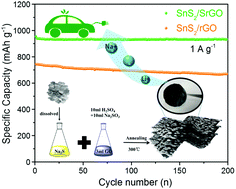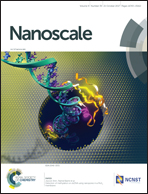Scalable synthesis of SnS2/S-doped graphene composites for superior Li/Na-ion batteries†
Abstract
Tin disulfide (SnS2) has emerged as a promising anode material for lithium/sodium ion batteries (LIBs/SIBs) due to its unique layered structure, outstanding electrochemical properties and low cost. However, its poor cycling life and time-consuming synthesis as well as low-yield production hinder the practical utilization of nanostructured SnS2. In this work, we demonstrate a simple and reliable dissolution–regeneration strategy to construct a flexible SnS2/sulfur-doped reduced graphene oxide (S-rGO) composite as anodes for LIBs and SIBs, highlighting its mass-production feature. In addition, the robust affinity between SnS2 and S-rGO without interstitial volume is very beneficial for preventing the SnS2 particles from breaking themselves away from the rGO nanosheets into free nanoparticles. As a result, the SnS2/S-rGO composite as anodes delivers high reversible capacities of 1078 mA h g−1 and 564 mA h g−1 (at 0.1 A g−1) for LIBs and SIBs, respectively, and excellent rate capabilities and cycling stability (e.g. 532 mA h g−1 during the 600 cycles at 5.0 A g−1 for LIBs). Our proposed strategy may also possess great potential for the practical application of other electrochemically active metal sulfide composites for energy devices.

- This article is part of the themed collection: Nanoscale 10th Anniversary: Top Authors


 Please wait while we load your content...
Please wait while we load your content...